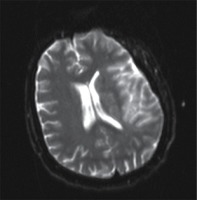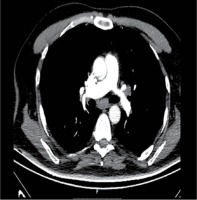COVID-19 may predispose to thromboembolic disease due to severe inflammation, hypoxia, and immobilisation [1]. The severe hypercoagulable state of COVID-19 patients includes systemic micro- and macrovascular thrombosis. Anticoagulant therapy, mainly with low-molecular-weight heparin, appears to be associated with better prognosis in severe COVID-19 patients [2].
A 45-year-old non-smoking male patient with no chronic disease and normal laboratory blood levels presented with fever, cough, and dyspnoea. Echocardiography did not show atrial fibrillation or atherosclerotic plaque. COVID-19 was diagnosed based on RT-PCR testing. There were no clinical or laboratory signs of a thromboembolic state, and the patient had no history of disseminated intravascular coagulation, venous thromboembolism, or patent foramen ovale shunt. After 4 days, the patient lost consciousness and had a seizure. The patient’s illness subsequently progressed to respiratory failure, warranting the initiation of non-invasive mechanical ventilation in the intensive care unit (ICU). Figure 1 depicts the diffusion brain magnetic resonance imaging (MRI) (T2-sequence) with no contrast and shows hyperintense areas in the cortical and subcortical areas at the left temporofrontoparietal level and at the left lentiform nucleus level. Pulmonary angiography (Figure 2) findings were compatible with thromboembolism in the right and left lung bases. In the ICU, the patient received antithrombotic therapy: enoxaparin sodium (6000 anti-Xa/0.6 ml, twice a day) and acetylsalicylic acid 100 mg. Levetiracetam 250 mg twice a day was started for seizures. On April 3, 2020, the patient was transferred to the neurological ward. He had right hemiplegia and aphasia.
Available evidence shows that markedly elevated D-dimer levels are associated with high mortality in COVID-19 patients [3]. Multi-organ failure is more likely in patients with sepsis if they develop coagulopathy, and inhibiting thrombin generation may have benefits in reducing mortality [4]. If there are no contraindications for patients requiring hospital admission for COVID-19 infection, prophylactic doses of low-molecular-weight heparin should be administered. The prophylactic enoxaparin dose recommended by the International Society of Thrombosis and Haemostasis on March 25, 2020 is 4000 U [3]. However, we suggest that this prophylactic dose is not sufficient to protect against thromboembolism. In many ICUs, higher doses have been used with the same rationale, confirmed by the data from Klok et al. from 184 patients, in whom most events (81%) were pulmonary embolism [5].
Antiphospholipid antibodies are common in the general population, especially during infection [6]. COVID-19 may induce a hypercoagulable state with elevated fibrinogen and prolonged PT and aPTT. The mechanisms underlying coagulopathy are not clear [7]. Zhang et al. reported that SARS-CoV-2 infection is associated with coagulopathy, thrombocytopaenia, and the presence of anticardiolipin IgA, anti-β2-glycoprotein I, IgA, and IgG antibodies, all of which are responsible for cerebral infarcts [8]. Lodigiani et al. analysed the rate, timing, and characteristics of venous/arterial thromboembolic complications among COVID-19 patients. Their results revealed that thromboembolic complications might represent an integral part of the COVID-19 disease and may already be present at the time of initial hospital admission [9]. We suggest that hypercoagulability caused by COVID-19 may cause ischaemia not only in the lungs but also in vital organs such as the brain.




